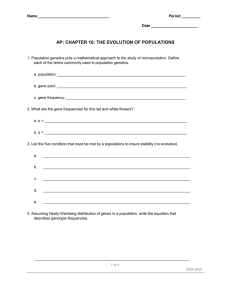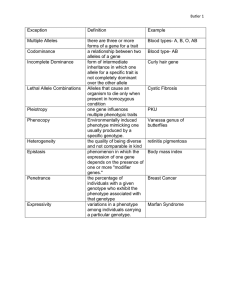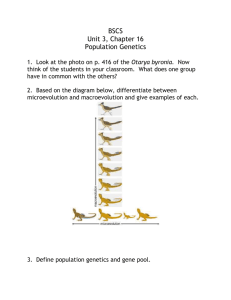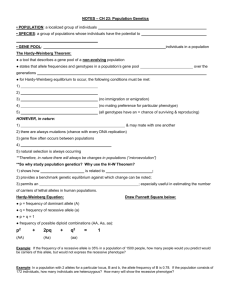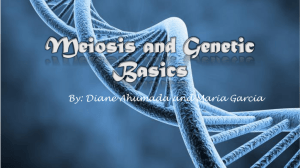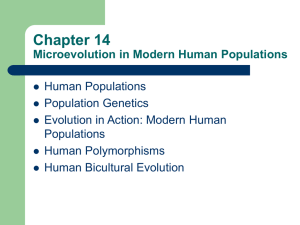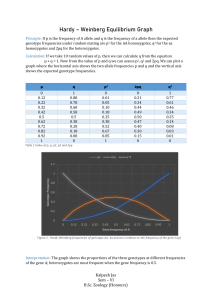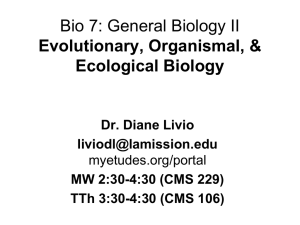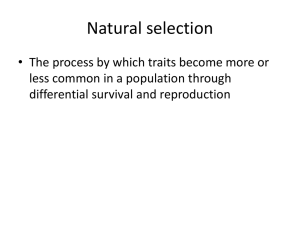CH23 Evolution of Populations
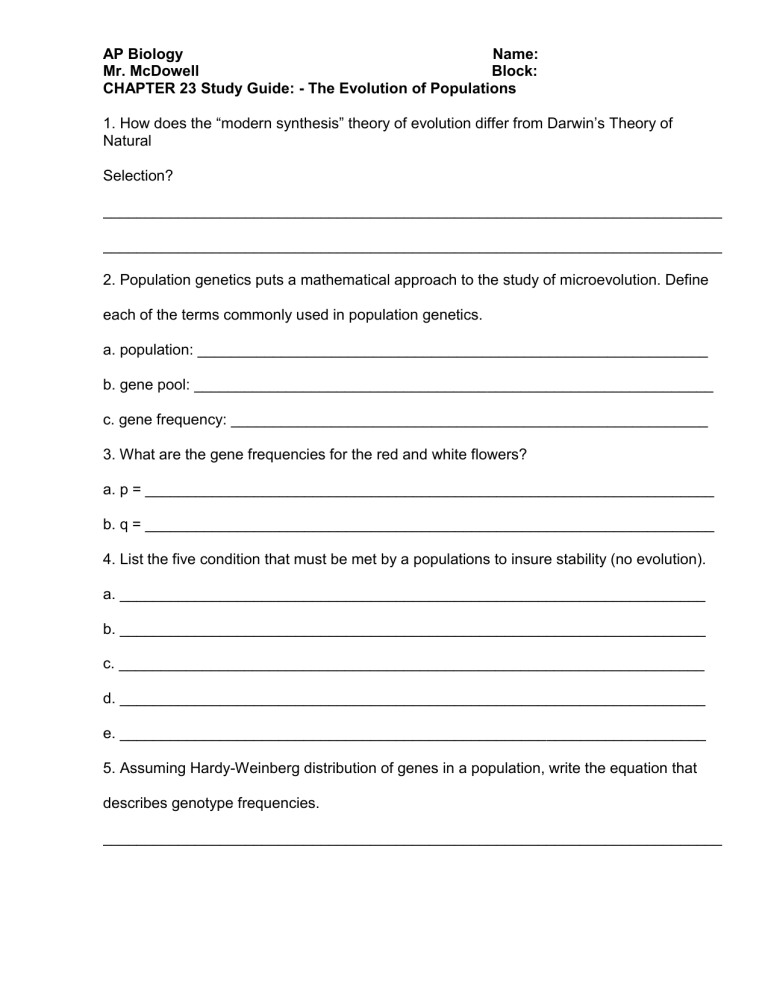
AP Biology Name:
Mr. McDowell Block:
CHAPTER 23 Study Guide: - The Evolution of Populations
1. How does the
“modern synthesis” theory of evolution differ from Darwin’s Theory of
Natural
Selection?
__________________________________________________________________________
__________________________________________________________________________
2. Population genetics puts a mathematical approach to the study of microevolution. Define each of the terms commonly used in population genetics. a. population: _____________________________________________________________ b. gene pool: ______________________________________________________________ c. gene frequency: _________________________________________________________
3. What are the gene frequencies for the red and white flowers? a. p = ____________________________________________________________________ b. q = ____________________________________________________________________
4. List the five condition that must be met by a populations to insure stability (no evolution). a. ______________________________________________________________________ b. ______________________________________________________________________ c. ______________________________________________________________________ d. ______________________________________________________________________ e. ______________________________________________________________________
5. Assuming Hardy-Weinberg distribution of genes in a population, write the equation that describes genotype frequencies.
__________________________________________________________________________
6. Define the following: a. p
2
= ___________________________________________________________________ b. 2pq = __________________________________________________________________ c. q
2
= ___________________________________________________________________
7. Work out these practice problems. Find both the gene and genotype frequencies: a. In Drosophilia , the allele for normal length wings is dominant over the allele for vestigial wings. In a population of 1,000 individuals, 160 show the recessive phenotype. b. The allele for the hair pattern called "widow's peak" is dominant over the allele for no
"widow's peak." In a population of 1,000 individuals, 360 show the dominant phenotype.
8. What is the H-W assumption that is broken when genetic drift occurs? Explain
__________________________________________________________________________
__________________________________________________________________________
9. How does genetic drift apply to each of the following? Give an example of each. a. Founders effect: _________________________________________________________
__________________________________________________________________________
__________________________________________________________________________ b. Bottleneck effect _________________________________________________________
__________________________________________________________________________
10. How do each of the following break H-W assumptions? a. natural selection: ________________________________________________________
__________________________________________________________________________ b. gene flow: ______________________________________________________________
__________________________________________________________________________ c. mutation: _______________________________________________________________
__________________________________________________________________________
d. selective mating: _________________________________________________________
__________________________________________________________________________
11. Why is genetic variation important to evolution?
__________________________________________________________________________
__________________________________________________________________________
12. How can populations vary along a geographic axis compared to isolated populations?
__________________________________________________________________________
__________________________________________________________________________
13. What is the role of mutations to forming variation?
__________________________________________________________________________
__________________________________________________________________________
14. What factors of sexual reproduction lead to variations within a population?
__________________________________________________________________________
__________________________________________________________________________
15. How does diploidy preserve variation?
__________________________________________________________________________
__________________________________________________________________________
16. What is “balanced polymorphism?”
__________________________________________________________________________
__________________________________________________________________________
17. How can parasites contribute to balanced polymorphism?
__________________________________________________________________________
__________________________________________________________________________
18. In a biological sense, what is fitness?
__________________________________________________________________________
__________________________________________________________________________
19. Label the following graphs of variation in color with the type of selection.
20. What is the effect of sexual selection?
__________________________________________________________________________
__________________________________________________________________________
21. For each of the following, give an example or describe what is meant by the statement. a. Natural selection cannot fashion perfect organisms: _____________________________
__________________________________________________________________________ b. Evolution is limited by historical constraints: ___________________________________
__________________________________________________________________________ c. Adaptations are often compromises: _________________________________________
__________________________________________________________________________ d. Not all evolution is adaptive: _______________________________________________
__________________________________________________________________________ e. Selection can only edit existing variations: ____________________________________
__________________________________________________________________________
